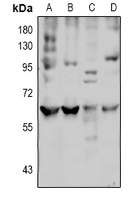Anti-LAT2 Antibody
Rabbit polyclonal antibody to LAT2
- SPECIFICATION
- CITATIONS
- PROTOCOLS
- BACKGROUND

Application
| WB |
|---|---|
| Primary Accession | Q9UHI5 |
| Other Accession | Q9QXW9 |
| Reactivity | Human, Mouse, Rat, Rabbit |
| Host | Rabbit |
| Clonality | Polyclonal |
| Calculated MW | 58382 Da |
| Gene ID | 23428 |
|---|---|
| Other Names | LAT2; Large neutral amino acids transporter small subunit 2; L-type amino acid transporter 2; hLAT2; Solute carrier family 7 member 8 |
| Target/Specificity | KLH-conjugated synthetic peptide encompassing a sequence within the center region of human LAT2. The exact sequence is proprietary. |
| Dilution | WB~~WB (1/500 - 1/1000) |
| Format | Liquid in 0.42% Potassium phosphate, 0.87% Sodium chloride, pH 7.3, 30% glycerol, and 0.09% (W/V) sodium azide. |
| Storage | Store at -20 °C.Stable for 12 months from date of receipt |
| Name | SLC7A8 (HGNC:11066) |
|---|---|
| Function | Associates with SLC3A2 to form a functional heterodimeric complex that translocates small and large neutral amino acids with broad specificity and a stoichiometry of 1:1. Functions as amino acid antiporter mediating the influx of extracellular essential amino acids mainly in exchange with the efflux of highly concentrated intracellular amino acids (PubMed:10391915, PubMed:11311135, PubMed:11847106, PubMed:12716892, PubMed:15081149, PubMed:15918515, PubMed:29355479, PubMed:33298890, PubMed:34848541). Has relatively symmetrical selectivities but strongly asymmetrical substrate affinities at both the intracellular and extracellular sides of the transporter (PubMed:11847106). This asymmetry allows SLC7A8 to regulate intracellular amino acid pools (mM concentrations) by exchange with external amino acids (uM concentration range), equilibrating the relative concentrations of different amino acids across the plasma membrane instead of mediating their net uptake (PubMed:10391915, PubMed:11847106). May play an essential role in the reabsorption of neutral amino acids from the epithelial cells to the bloodstream in the kidney (PubMed:12716892). Involved in the uptake of methylmercury (MeHg) when administered as the L-cysteine or D,L-homocysteine complexes, and hence plays a role in metal ion homeostasis and toxicity (PubMed:12117417). Involved in the cellular activity of small molecular weight nitrosothiols, via the stereoselective transport of L- nitrosocysteine (L-CNSO) across the transmembrane (PubMed:15769744). Imports the thyroid hormone diiodothyronine (T2) and to a smaller extent triiodothyronine (T3) but not rT 3 or thyroxine (T4) (By similarity). Mediates the uptake of L-DOPA (By similarity). May participate in auditory function (By similarity). |
| Cellular Location | Cell membrane; Multi-pass membrane protein. Basolateral cell membrane; Multi-pass membrane protein. Note=Localized to the cytoplasm when expressed alone but when coexpressed with SLC3A2/4F2hc, is localized to the plasma membrane. Colocalized with SLC3A2/4F2hc at the basolateral membrane of kidney cortex proximal tubules and small intestine epithelia of the villi. |
| Tissue Location | Strongest expression is observed in kidney and moderate expression in placenta and brain, followed by liver, prostate, testis, ovary, lymph node, thymus, spleen, skeletal muscle and heart Also expressed in fetal liver as well as in the retinal pigment epithelial cell line ARPE-19 and the intestinal epithelial cell line Caco-2. |

Thousands of laboratories across the world have published research that depended on the performance of antibodies from Abcepta to advance their research. Check out links to articles that cite our products in major peer-reviewed journals, organized by research category.
info@abcepta.com, and receive a free "I Love Antibodies" mug.
Provided below are standard protocols that you may find useful for product applications.
Background
KLH-conjugated synthetic peptide encompassing a sequence within the center region of human LAT2. The exact sequence is proprietary.
If you have used an Abcepta product and would like to share how it has performed, please click on the "Submit Review" button and provide the requested information. Our staff will examine and post your review and contact you if needed.
If you have any additional inquiries please email technical services at tech@abcepta.com.













 Foundational characteristics of cancer include proliferation, angiogenesis, migration, evasion of apoptosis, and cellular immortality. Find key markers for these cellular processes and antibodies to detect them.
Foundational characteristics of cancer include proliferation, angiogenesis, migration, evasion of apoptosis, and cellular immortality. Find key markers for these cellular processes and antibodies to detect them. The SUMOplot™ Analysis Program predicts and scores sumoylation sites in your protein. SUMOylation is a post-translational modification involved in various cellular processes, such as nuclear-cytosolic transport, transcriptional regulation, apoptosis, protein stability, response to stress, and progression through the cell cycle.
The SUMOplot™ Analysis Program predicts and scores sumoylation sites in your protein. SUMOylation is a post-translational modification involved in various cellular processes, such as nuclear-cytosolic transport, transcriptional regulation, apoptosis, protein stability, response to stress, and progression through the cell cycle. The Autophagy Receptor Motif Plotter predicts and scores autophagy receptor binding sites in your protein. Identifying proteins connected to this pathway is critical to understanding the role of autophagy in physiological as well as pathological processes such as development, differentiation, neurodegenerative diseases, stress, infection, and cancer.
The Autophagy Receptor Motif Plotter predicts and scores autophagy receptor binding sites in your protein. Identifying proteins connected to this pathway is critical to understanding the role of autophagy in physiological as well as pathological processes such as development, differentiation, neurodegenerative diseases, stress, infection, and cancer.


